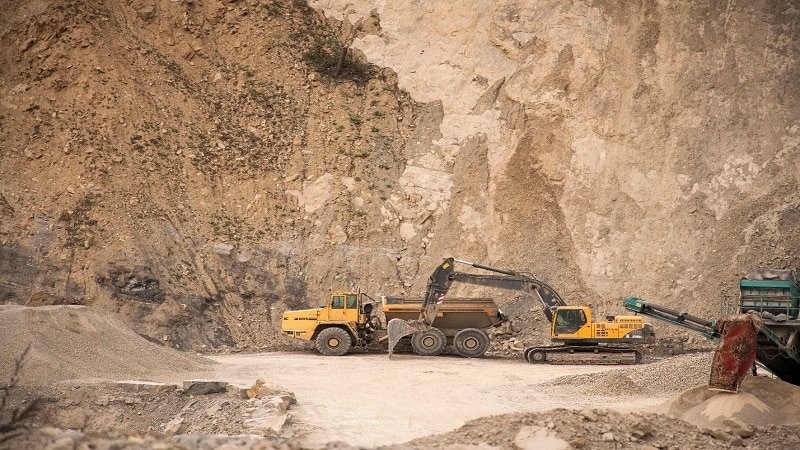How Is Turquoise Mined?

Turquoise is an opaque mineral deposit typically found in shades of bright blues, greens, and yellows – if not a mix of all three. The stones are common to arid regions across Iran, Egypt, China, Afghanistan, Chile, northern India, and the United States, occurring naturally as copper and aluminum phosphates with the chemical formula CuAl6(PO4)4(OH)8·4H2O.
Turquoise is considered to be a unique mineral since very few minerals other than copper, gold, and silver can boast of a color composition so well-known that the English language even uses the word ‘turquoise’ to describe the greenish-blue shade. It is this eye-catching color that affords turquoise its popularity amongst jewelers, sculpture artists, and manufacturers of inlays for furniture, etc., from ancient times to today.
Unfortunately, these bold and beautiful little gems are not always so easy to find. And even if you are lucky enough, retrieving them can be even more arduous. To understand how turquoise is mined, we must find out how it is formed first.
How Is Turquoise Formed?
Turquoise is a secondary mineral that germinates as a result of percolating acidic aqueous solutions which become active during the weathering and oxidation of other, pre-existing, primary minerals. Usually, the mineralization occurs at relatively shallow depths (less than 20 meters or 66 feet), in cavities of highly modified volcanic rocks, but it can also take place in deeper fractures where secondary solutions have higher penetration, or the water table is higher.
What happens is that rainfall infiltrates the ground, dissolving small pockets of copper. When the water evaporates later, it combines with aluminum and phosphorus to form turquoise deposits in the walls of the sub-surface fractures. At times, the turquoise replaces the rock that first came in contact with the rainwater completely, thereby creating a solid, massive stone.
Finding the Turquoise
Like all kinds of mining processes, retrieving turquoise also begins with the prospecting stage. After all, one needs to know where to look before they can dig in. The surrounding climate is of grave importance here. Experts study everything from the formation of the mountains to the color of the earth and the overall temperature in the region to determine where to start. At times, locating a good turquoise deposit can take up to months as it must be done manually.
At times, miners end up finding several other minerals on the sites, instead of turquoise. These minerals look quite similar and get misidentified in the market as being of value. Variscite, chalcosiderite, and magnesite are the most common examples of minerals often thought to be turquoise. One can avoid this by looking for yellow, white, brown, or green in the stone. If even a hint of these shades is visible to the naked eye, the stone is most likely not turquoise.
Digging the Turquoise
The process is much more labor-intensive than one would expect, despite assistance from modern machinery. Shovels, picks, and hammers, even fingernails, are routinely worn out before the heavenly jewels get to see the light of day.
After a potential site has been found, heavy equipment is used to drill holes into the ground to gain access to the fissures within – fissures which, hopefully, contain large amounts of turquoise. Once the holes are in place, they are loaded with dynamites that blast the rock to ‘loosen’ it up. This unleashes clouds of dust and dirt particles into the air, yes, but that is an unavoidable consequence of mining any stones.
Filtering the Rubble
Once the particles settle, miners employ backhoes and excavator trucks to dig out all the host rock, which is then run over a screen to eradicate the dirt and dust. The mound is put into a cement mixer to begin the ‘tumbling’ process which filters out the turquoise stones from the earth. The amount of time taken to do this depends on the mine and the amount of earth removed.
The tumbling process is designed to remove the coating of dirt on the turquoise nuggets, lest they be overlooked and thrown away. After this, the rocks are washed and sifted through to retract all the visible stones. At this point, the miners’ work is nearly complete. All that is left is to send the goodies to the cutting shop, where they can be prepped for sale.
Grading the Turquoise
To grade any gemstone, one must know and understand the many physical properties that comprise it. This will help determine its value and ultimately, its price.
When it comes to grading turquoise, never forget to take the natural processes of Mother Nature into account. Weathering can significantly alter the overall makeup of the stones, affecting everything from their color to their opaqueness and durability. Weathered turquoise can still look desirable, but it is usually softer and less durable. Hence, it is not advisable for use in jewelry or ornaments, etc. Craftsmen usually crush it to make “composite” or “reconstituted” stones to sell later.
That said, hardly any of the turquoise mined today can be utilized as finished stones without some sort of treatment to boost durability or improve color and size, etc. Untreated turquoise is rare and so, considered to be the highest-grade turquoise in the world.